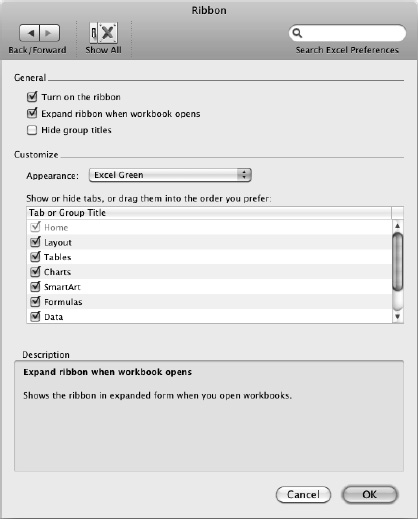Turning Off or Customizing the Ribbon
As you learned in Chapter 1, you can also customize the Ribbon—only a little compared to the full-on changes you can make to the toolbars and the menu bar—but still enough to help. You can control the Ribbon's behavior and appearance, and you can choose which tabs appear and their order.
You can also turn the Ribbon off completely. We start with this topic.
NOTE: While using this book as a reference, you'll probably find it easiest to keep the Ribbon onscreen with all its standard tabs displayed. If you hide or customize the Ribbon, finding the commands you need will be harder.
Turning the Ribbon Off So It Doesn't Appear
Collapsing the Ribbon gives you more screen space, but you may want to try turning the Ribbon off altogether to see if you can do without it. If so, follow these steps:
- Click the Set Ribbon Preferences or Tab Order button (the cog button) at the right end of the Ribbon, and then click Ribbon Preferences. Excel displays the Ribbon preferences pane (see Figure 2–12).

Figure 2–12. In the Ribbon preferences pane, you can turn off the Ribbon altogether, hide the names of Ribbon groups, or customize the tabs that appear in the Ribbon all the time.
- In the General area, clear the Turn on the ribbon check box.
- Click the OK button to close the Excel Preferences dialog box.
NOTE: When you want to turn the Ribbon on again, choose Excel ![]()
Preferences or press Cmd+, (Cmd and the comma key) to display the Excel Preferences dialog box, then click the Ribbon icon in the Sharing and Privacy category. Then select the Turn on the ribbon check box, and click the OK button.
Customizing the Ribbon
You can customize the Ribbon by choosing which tabs to display and the order in which to display them. You can't get rid of the Home tab or change its position, but you can suppress or move any of the other tabs.
Customizing the Ribbon the Quick Way
The quick way to customize the Ribbon is to click the Set Ribbon Preferences or Tab Order button (the cog button) at the right end of the Ribbon, and then click Customize Ribbon Tab Order on the pop-up menu. Excel displays a × button and a handle (three vertical bars) on each tab except the Home tab (see Figure 2–13).

Figure 2–13. You can customize the Ribbon by dragging its tabs into your preferred order or by removing the tabs you don't need. Click the Done button when you finish.
You can then click a tab and drag it to where you want it, or click a tab's button to remove it. When you finish customizing the tabs, click the Done button. And if you mess up, click the Reset button to restore the tabs to their normal setup.
Customizing the Ribbon Using the Ribbon Preferences Pane
The other way to customize the Ribbon is by using the Ribbon preferences pane. Use this method when you want to control whether Excel automatically expands the Ribbon when you open a workbook, when you want to hide the names of Ribbon groups, and when you want to redisplay tabs you've hidden (without having to reset the Ribbon as a whole).
To customize the Ribbon using the Ribbon preferences pane, follow these steps:
- Click the Set Ribbon Preferences or Tab Order button (the cog button) at the right end of the Ribbon, then click Ribbon Preferences. Excel displays the Ribbon preferences pane (shown in Figure 2–12, earlier in this chapter).
- In the General area at the top, clear the Expand ribbon when workbook opens check box if you don't want Excel to automatically expand the Ribbon in each workbook you open. Some people find this automatic expansion helpful; others don't.
- Also in the General area, select the Hide group titles check box if you want to prevent the names of groups from appearing. Hiding the group titles makes the Ribbon a little shallower, so you may want to try it if you're pushed for space. But it will make following the instructions in this book harder, because they include the groups in Ribbon commands.
- In the Appearance pop-up menu, choose Graphite if you want to make the Ribbon tabs gray rather than the default Excel Green.
- In the “Show or hide tabs, or drag them into the order you prefer” list box, set up the tabs the way you want them:
- Clear the check box for any tab you don't want to display.
- Drag the tabs into the order you want.
- Click the OK button to close the Excel Preferences dialog box.
NOTE: At the bottom of the “Show or hide tabs, or drag them into the order you prefer” list box, you find the Developer tab. This tab contains controls for working with Visual Basic for Applications (VBA, the programming language built into the Office applications), running add-ins, and building forms with controls such as check boxes, list boxes, and command buttons.
